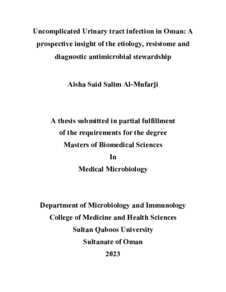Document
Uncomplicated urinary tract infection in Oman : a prospective insight of the etiology, resistome and diagnostic antimicrobial stewardship.
Source
Master's thesis
Other titles
عدوى المسالك البولية غير المعقدة في سلطنة عمان : رؤية مستقبلية لمسببات المرض والمقاومة والتشخيص لمضادات الميكروبات
Country
Oman
City
Muscat
Publisher
Sultan Qaboos University
Gregorian
2023
Language
English
Subject (Name)
Thesis Type
Master's thesis
English abstract
Background: Community-acquired uncomplicated urinary tract infections (caUTIs) are more
common in women and increasing with age, pose a significant health threat. To address global
antimicrobial resistance, the study prioritized diagnostic and antimicrobial stewardship. In
diagnostic stewardship, it assessed Knowledge, Awareness, and Practice (KAP) regarding
antibiotics and urine sample collection among outpatient department (OPD) nurses and patients.
The research aimed to explore caUTI etiology, analyze antimicrobial susceptibility, ESBL/AMPC resistance, assess non-routine antibiotics' feasibility for resistant isolates, examine in-vitro
synergy for BL/BLI combinations, and investigate UTI isolates' MLST and phylogenetic
relatedness through whole genomic sequencing.
Methods: A sample of 82 OPD patients and 53 OPD nurses were questioned in the OPD clinics
at the Sultan Qaboos University Hospital (SQUH) and A’seeb Polyclinic, in the purpose of
investigating KAP of urine collection and antibiotic usage among patients and nurses. For
phenotypic testing, a total of 112 consecutive Gram-positive and Gram-negative isolates from
routine mid-stream urine samples were collected for 104 female patients of reproductive age (15-
50 years) suffering from caUTIs. The BD Phoenix automated system was used to assess the
phenotypic characteristics, ESBL and AmpC detection and antibiogram of the test strains, with
the interpretation of antimicrobial susceptibility conducted based on the CLSI 2022 guidelines.
This routine testing encompassed an extensive panel of antibiotics, as well as additional
antibiotics that not routinely tested in the SQUH Diagnostic Laboratory, which were: temocillin
(TMO), fosfomycin (FOS), nitroxoline (NI), netilmicin (NET), and mecillinam (MEC). DNA
was extracted from 26 isolates. Genomic sequences were characterized using house-keeping
genes to determine allelic profiles or sequence types (ST) through the multilocus sequence
typing (MLST) tool. The 26 isolates were subjected to Whole Genome Sequencing (WGS) for
the detection of antibiotic-resistance genes, the determination of the resistance mechanisms, the
determination of the plasmids and virulence genes.
Results: The patient survey identified flank pain (26.8%) as the most reported UTI symptom.
Only 37.8% received urine sample collection instructions, and 51.2% noted nurses' hand
hygiene. The nurses survey revealed 96.2% acknowledging the significance of hand hygiene.
Awareness of antimicrobial resistance among nurses and its connection to frequent use was
shown by 79.02% and 84.9% agreed antibiotics should be exclusively for bacterial infections. A
minority (15.1%) always informed patient about potential UTIs. In phenotypic testing,
uropathogens (E. coli 62%, K. pneumoniae 18%) showed varied susceptibilities. E. coli exhibited
higher susceptibility to nitrofurantoin, piperacillin-tazobactam, carbapenems, aminoglycosides,
and ceftazidime-avibactam. K. pneumoniae had higher susceptibility to carbapenems,
aminoglycosides, and ceftazidime-avibactam. An examination of 112 isolates from 104 caUTI
patients highlighted E. coli (59%) as the primary causative agent. ESBL prevalence was 8% in
pregnant E. coli and 13% in non-pregnant E. coli. For AmpC, 2% was observed in pregnant K.
aerogenes, and 2% in non-pregnant K. aerogenes and P. aeruginosa. Disk approximation tests
revealed cefoxitin-resistant isolates with lower susceptibility. Antibiotic susceptibility profiles
showed zero resistance to mecillinam, temocillin, netilmicin, nitroxoline, and fosfomycin. WGS
data of 26 E. coli isolates indicated genetic diversity and identified plasmids, antimicrobial
genes, and mechanisms contributing to resistance. The agreement between genotypic and
phenotypic expression for antimicrobial resistance genes ranged from 22.70% to 100%. WGS
unveiled 57 VFs, with high prevalence in ST-73 and ST-998 lineages. ESBL genes (CTX-M-27
most prevalent) and AmpC gene (DHA) were identified.
Conclusion: The study highlighted the importance of patient education, hand hygiene
compliance, and responsible antibiotic use in the management of UTIs. In addition, the findings
highlight the importance of responsible antibiotic prescribing, infection control measures, and
stewardship programs in combating antibiotic resistance and promoting effective antibiotic use
in healthcare settings. The use of five novel antibiotics (mecillinam (MEC), fosfomycin (FOS), netilmicin (NET), temocilin (TMO) and nitroxoline (NI)) is recommended for caUTIs. The identification of plasmids and antimicrobial resistance genes helped in understanding the
different antimicrobial resistance mechanisms and epidemiology and the distribution of virulence
factors. As part of the surveillance and monitoring activity of antibiotic resistance for infection
control, performing both phenotypic and genotypic analysis is crucial.
Category
Theses and Dissertations

